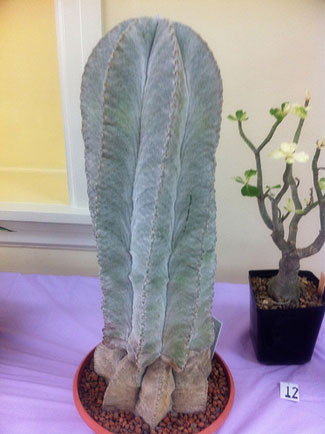Resource Library
Plant of the Week: Cactus, Bishop's Hat

BISHOP’S HAT -- This venerable old Bishop’s Hat Cactus is 86 years old and is being cared for by its third owner. (Image courtesy Gerald Klingaman)
Catus, Bishops Hat
Latin: Astrophytum myriostigma
History swarms around plants like the strands of cotton candy around the paper handle. Each strand, if teased apart, leads in a new direction and makes many unexpected connections as it is followed to its source. These histories may take on wide sweeps encompassing everything from drifting continents to swashbuckling plant explorers to businessmen jockeying for position in the marketplace of the modern plant world.
Sometimes, as with this specimen of Bishop’s Hat, or Bishop’s Cap cactus (Astrophytum myriostigma), the history is the personal tale of a single plant specimen that has survived for 86 years with the care of three owners who have each given it the care needed to keep it chugging along.
Bishop’s hat cactus is one of five species of Astrophytum native to the highlands of central Mexico. The genus name translates as from Greek as “star plant”, a reference to the star like shape of the cactus body when viewed from above. These ribbed sections allow the cactus body to shrivel or expand as needed depending on the plentitude or scarcity of rainfall in their desert home.
Bishop’s Hat cactus usually has five ridges but the number usually increases as the plant ages. It is usually seen in cactus collections as a round, softball sized globe with a silver-gray body due to the presence of tiny trichomes that cover the body of the plant and serve as natural sunscreen. In shady sites, these may be missing and the plant body green in color. With age, the plant body begins to elongate and eventually forms a stout columnar plant 2 to 3 feet tall. This species is thornless but has tufts of soft, short-spine bearing areoles up the outer rib of each segment.
Fragrant, 2-inch diameter light yellow, multi-petaled flowers are produced singly from the areoles at the top of the plant during the summer. If pollinated the hairy, inch-long reddish fruit is produced which the Tarahumare Indians used as a hallucinogenic in ceremonies and called false peyote.
Affixed to the Bishop’s Hat cactus I photographed at the Tulsa Cactus and Succulent sale and plant show was a sign telling a bit of history of the venerable old specimen. Its seeds were planted in Texas on June 1, 1926, and the first owner cared for it for 50 years, leaving it in his will to the second owner who tended it for another 37 years.
The third owner had just been bequeathed the plant and now had the responsibility for keeping it going. These owners, all acquainted through their membership in the Cactus and Succulent Society of America, all had the temperament and interest to provide the modest but ongoing care needed to keep the plant alive and well for nearly a century.
I often hear stories of plants passed down in families from mother to daughter, but usually these are peonies or asparagus fern or something similar that can be increased by vegetative propagation, making multiple copies of the plant being preserved. This old cactus has never been cloned, so it survives as an individual specimen. Both are good examples of heirloom plants being preserved but the exactitude required to care for a single, unique individual must be a bit more daunting in its undertaking.
While Bishop’s Hat cactus is winter hardy to about 20 Fahrenheit outside, it is almost always grown as a pot plant. As a cactus it is relatively easy to grow requiring bright light and a well-drained soil. Like most cacti, water is withheld during the cold months of winter, maybe being applied only once every 4 to 6 weeks while the plant is dormant. In the summer plants are often moved out of doors and natural rainfall allowed to provide the water. If no rainfall occurs, weekly watering is usually about right as long as the soil is well drained.
Repotting is required but the urge should be resisted as long as possible. Pot size should be increased very slowly over the decades because too large a pot (and hence too wet a soil mass) will encourage root rot which is the most often killer of these old plants. Repotting once every 5 to 10 years is probably about right with the old soil gently removed from the roots and replaced with fresh soil.
By: Gerald Klingaman, retired
Retired Extension Horticulturist - Ornamentals
Extension News - February 21, 2014